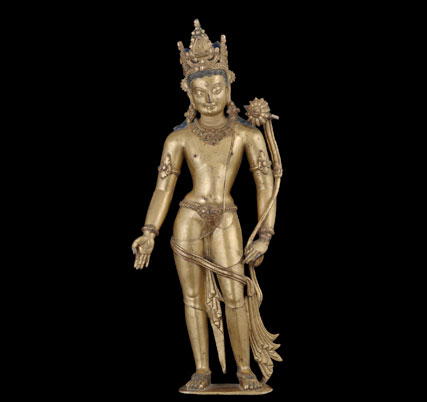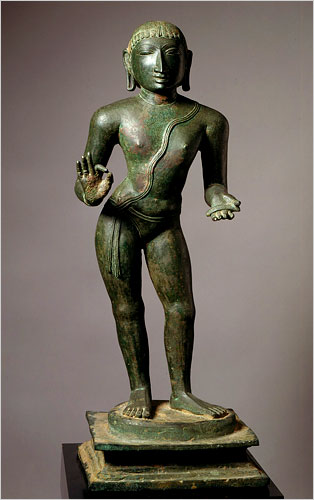More Gods, Saints
and Epic Flying Heroes
By HOLLAND COTTER
Anyone interested in Buddhist sacred art will want to sample some
of these special, open-to-the-public exhibitions in Manhattan
for Asia Week.
John Eskenazi (24 East 80th Street) should be a first stop and
a return visit. You won’t find anything in the city more
beautiful than the eighth-century Sri Lankan bronze Buddha Mr.
Eskenazi has brought with him from London. With its slender limbs
and water-thin robe washing over its torso, this figure is a reminder
that in Buddhism many cultures merge. In this case India, China
and Southeast Asia meet in a distinctive island art.
Other knockouts include a resplendent gilded-bronze Padmapani,
probably cast in Tibet by an artist from the Katmandu Valley,
and a jumbo clay bodhisattva’s head from Gandhara. This was
the area where classical Western influences filtered into India,
though its easy to imagine influences going the other way too.
Bernini would have been blown away by this grand head, with its
mop of deep-cut curls and proto-Baroque-crown.
Across town at the Ansonia (2109 Broadway, entrance on West 73rd
Street), Nancy Wiener is also showing a head, this one life size,
carved in stone and as severe as Mr. Eskenazi’s is ornate.
It comes from the vanished stupa at Amaravati, once a magnet for
pilgrimages and a source of a great Indian sculptural style.

Ms. Wiener has consistently rustled up outstanding
Southeast Asian work for Asia Week. This year is no exception
on the evidence of her 11th-century Khmer carving of the Buddha
sitting on the coiled body of the serpent king Muchalinda, who
protected him at Bodh Gaya. The Buddha’s form is all but
abstract, but the snake’s is straight from nature: you can
see the curving spine under the skin, and every inch of skin is
incised with fine, scalelike patterning.
Back on the Upper East Side, China 2000 (434A East 75th Street),
in new town house quarters, makes a hanging scroll from the Yuan
dynasty (1271-1368) its centerpiece. The painting is a devotional
image of the Buddha called Vast Myriad Virtue of the Zenith. Dressed
in tulip pink, he is a winsome presence and surrounded here by
implements from Chinese scholars’ studios: ink stones, seals
and brushes that might be thought of as secular versions of liturgical
instruments used by true art devotees, serious painters who were
also serious collectors.
Collecting is the theme at Carlton Rochell (44 East 74th Street),
where everything is from a single private collection put together
in the 1970s and ’80s by a pair of New Yorkers, Robert and
Bernice Dickes. The eye-grabber is a Tibetan bronze of Avalokiteshvara,
multi-armed bodhisattva, studded with turquoise and wearing a
stack of heads in his crown.
But my take-home choice might be one of several painted illustrations
of popular Hindu epics like the “Bhagavata Purana” and
the “Ramayana.” The contents of these courtly pictures
are far removed from tough-love Buddhist austerities. When the
hero Rama wants news of his wife, Sita, the object of his undying
desire, he doesn’t let mountains stand in his way: he flies
over them.
A glance at the show’s catalog reveals that the Dickeses
bought several of their paintings, as well as their Avalokiteshvara,
from the New York City dealer Doris Wiener. Ms. Wiener, mother
of Nancy and a veteran of the Asian art field, has kept a low
profile in the years since the International Asian Art Fair disappeared.
But she’s back this spring with a show, opening Saturday,
in her apartment gallery (1001 Fifth Avenue, at 81st Street).
She says her show is basically made up of things she pulled out
of her closets. Some closets: they were packed with Tibetan tankas
as pristine as the day they were painted; joyous early Buddhist
stone sculptures; and a painted 15th-century carved-wood Nepalese
Tara, who wears a smile, a crown, an apron and that’s all.
March 19, 2010
Doris Wiener Gallery

A bronze sculpture of Manikkavachakar, a Hindu saint.
The prizes, though, are the South Indian bronze figures of Hindu
saints. One of them, Manikkavachakar, was a historical figure
who probably lived in the ninth century A.D. A prodigy, he was
appointed chief minister to a king when he was very young. But
he soon found his real calling and spent most of the rest of his
life in the Shiva temple at Chidambaram, writing and singing passionate
hymns.
In the end he entered its inner sanctum and disappeared. In sculptures
he holds a little book in one hand and leans forward as if he
had something to tell you. It must be something very wonderful.
For centuries people have been coming to temples to hear him.
Their visits are part of an ancient pilgrimage tradition surrounding
Tamil saints. And that’s a story for a future Asia Week.
http://www.nytimes.com/2010/03/19/arts/design/19basia.html